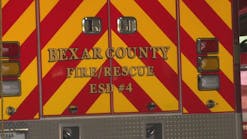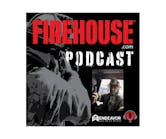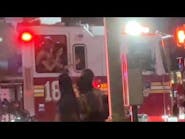OH Firefighter Museum Head, Ex-Assistant Chief Dies
By Mark Zaborney
Source The Blade, Toledo, Ohio
Robert J. Schwanzl, a 40-year Toledo firefighter who retired as assistant fire chief, and a longtime leader of the Toledo Firefighters Museum, who in resonant tones shared the department’s legacy, died Friday in his Monclova Township home. He was 87.
He suffered organ failure, his son Mike Schwanzl said. He had been dealing with bladder cancer and had an abdominal aneurysm.
Chief Schwanzl was appointed a Toledo firefighter Sept. 1, 1958. He retired March 5, 1998. Later that year, he received a Distinguished Service Award during a Ohio Fire Marshal honors dinner.
“I still feel it’s very unusual that I’m getting an award for something that I just love to do,” Chief Schwanzl told The Blade beforehand.
At his death, he had been president since 1993 of the Toledo Firefighters Museum, located on West Sylvania Avenue in a former fire station where he once served. For visitors, he made vivid the stories of the exhibits and artifacts, the building, and his firefighting forebears.
He offered remarks at graduation ceremonies for new Toledo firefighting classes. Until he became ill, he often delivered the Last Alarm service at firefighters’ funerals.
“He felt that was his duty, to pay his respects to the people in the department. We all hoped he would be the one saying that for us,” said Joe Walter, a former Toledo assistant fire chief and a former city safety director.
“Everybody who worked with Bob Schwanzl looked up to him, respected him because of his knowledge of the job and his integrity,” Mr. Walter said.
Chief Schwanzl was known for his deep, booming voice — at home; on duty calmly directing operations at a multiple-alarm blaze, or expounding on the significance of the fire memorial in Chub DeWolfe Park downtown.
“He had a command voice,” Mr. Walter said.
Renzo Maraldo, a retired battalion chief said: “It was like God is talking to you. You’d hear the voice coming out of the cloud, and it was his voice.”
He was born June 14, 1933, in Toledo to Alma and Wilbur Schwanzl. He was a 1951 graduate of Central Catholic High School. Years later he received an associate degree in fire science from what is now Owens Community College.
He was an Army veteran, discharged as a sergeant after paratrooper training stateside at the end of the Korean War and then duty in a Washington-area intelligence unit.
Back in Toledo, he drove a cab, sold encyclopedias door to door, and worked in supermarket produce sections.
“He realized he needed a more sustainable future going forward,” his son said. His paternal grandfather had been a firefighter, and he took police and fire tests. The fire division, as it was then known, called first, and he responded.
He served at stations No. 5, then at Broadway and Logan Street; at the former No. 7, which then faced Bancroft Street, at the former No. 18 — the future museum — and the new No. 18 on Lewis Avenue, and No. 25 on Central Avenue.
He advanced in rank, becoming a district chief in 1981 and later a deputy chief and assistant chief.
He oversaw training and then the fire prevention bureau. He helped lead Toledo in becoming the first Ohio fire department to require emergency medical training for every firefighter. He oversaw an updating of the city’s fire code, developed the physical competency test for firefighters, and saw the first nine women join the fire service.
“He really enjoyed teaching, both formally and leading by example,” his son said.
Tragedy informed that calling. He was among the responders on June 10, 1961, when a gasoline tanker truck on the Anthony Wayne Trail crashed, burned, and then exploded. Four firefighters died and 71 people, including firefighters and civilians, were injured.
“I remember walking up to a scene of devastation. It was the worst,” he said at his retirement. “It’s because we’ve had disastrous incidents like those that we’ve been able to learn from those incidents.”
The year before, at the annual firefighters memorial, on the anniversary of the Trail Fire, he said: “I didn’t know if I was going to get through it. I knew the people very well.”
But, he said, he learned to move on — and how to improve himself and the department.
“This is a lesson that you learn. It’s hard, but you do it,” Chief Schwanzl said in 1997. The department 36 years later was “much better trained, better prepared, better skilled.”
A devout Catholic, he was a member of St. Joseph Church, Maumee, and was a former Grand Knight in the Knights of Columbus. He saw Pope Francis twice — in Vatican City and Philadelphia — took part in the Padre Pio Prayer Group locally and, in 2017, attended the beatification Mass at Ford Field in Detroit of Venerable Solanus Casey.
He and the former Carolyn Murray married June 14, 1958. She died July 26, 2011.
Surviving are his sons Michael and Joseph Schwanzl; daughters Marie Mason and Angela Schweickert, of Sylvania; sister, Janet Molik; 15 grandchildren, and three great-grandchildren;.
Visitation will be from 2-8 p.m. Wednesday at the Coyle Funeral Home, with a Last Alarm service at 7 p.m. Funeral services are to begin at 9:30 a.m. Thursday in the mortuary, with a Mass at 10:30 a.m. in St. Joseph Church, Maumee, where he was a member. Visitors will be required to wear a mask.
The family suggests tributes to the Toledo Firefighters Museum or St. Joseph Church, Maumee.
———
©2020 The Blade (Toledo, Ohio)
Visit The Blade (Toledo, Ohio) at www.toledoblade.com
Distributed by Tribune Content Agency, LLC.






